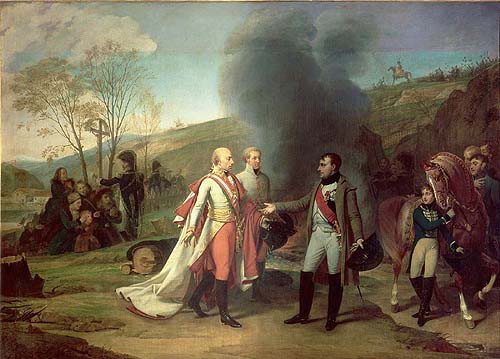A decree passed on 3 March, 1806, ordered the commissioning of 18 paintings in commemoration of the great moments of Napoleonic rule. They were all destined for the Galerie de Diane in the Tuileries palace, and they were all (without exception) to be finished by the Salon of 1808. The victorious campaign of 1805, and in particular the Battle of Austerlitz, took the lion’s share of subjects on the list. Gautherot was to paint the Emperor addressing the 2nd corps at Augsbourg; Hennequin, the beaten Austrian army after Ulm; Taunay, the entry into Munich; Girodet, the entry into Vienna; Lejeune and Meynier, the bivouacs the day before the battle of Austerlitz, and Gérard, general Rapp presenting the standards taken from the enemy at Austerlitz. As for Gros, he was ordered to reproduce the interview of Francis II of Austria and Napoleon I of France after the battle. The painting, incomplete in 1808, was not to be shown until the Salon of 1812, although this was not really the painter’s fault; in the meantime he had received another commission, this time to paint the Battle of Eylau, which was in the end to be one of his masterpieces.
Two days after Austerlitz, 4 December 1805, the meeting between Francis and Napoleon was organised at Sarutschitz, in Moravia, at the hamlet called the Burnt Mill, a site which today has a commemorative plaque describing the meeting as: “a calm two hour conversation [which ended] the bloody war which they had pursued”. Gros appears to have given an accurate rendering of the scene: it took place near a road, in a very simple setting. Only a log on which to sit and a fire softened the historical moment when Napoleon welcomed Francis with the words: “I receive you in the only palace I have lived in these past two months”. Moving away from their respective escorts, the two sovereigns remained standing, the conversation passing via the interpreter Feld Marschal Johann von Lichtenstein.
For Gros, gesture was always important. This is particularly true of painting of the Plague victims of Jaffa, not to mention the battlefield of Eylau, where Napoleon stretches out a sympathetic hand. Here again it is Napoleon’s outstretched hand which attracts the most attention. This gesture of reconciliation is lit up, whilst the face and the silhouette is slightly masked by the smoke from the fire burning behind the group. It must be said however that in this winter scene, Gros’s talent appears only fitfully, notably the horse on the right. Here the composition is maladroit, and the painting in no way bears the epic stamp of this artist’s other great works.
Karine Huguenaud (tr. P.H.)
December 2005


